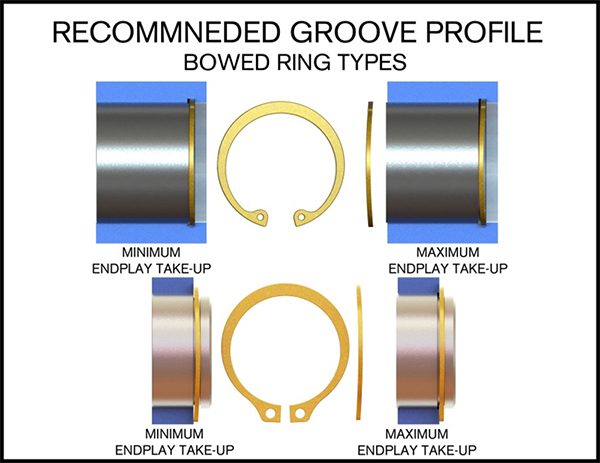Technical Considerations for the Selection of Retaining Rings
 |
||
|
TECHNICAL CONSIDERATIONS FOR THE SELECTION OF RETAINING RINGS |
||
|
|
||
| Part 3 of 6 : BOWED RINGS FOR RESILIENT ENDPLAY TAKE-UP |
||
| Retaining rings can also be used to compensate for accumulated tolerances or wear in the assembly, and also to exert pressure against the retained parts. Most retaining rings are made from spring materials and are heat-treated to retain their resiliency. The bowed rings (Figure 6) can be flattened under pressure and will return to their set height when pressure is released. It follows then that when the ring is flattened either partially or completely, it exerts counter-pressure in much the same way as a spring, taking up endplay. | ||
| Figure 6 | ||
| In the two illustrations above in Figure 6, compression is minimal, whereas on the right both rings are flatter. The flatter rings indicate that the retained parts were slightly longer and the rings adjusted themselves to this condition. Because of their resiliency, bowed rings will “follow” any axial movement of the retained part within the limitations of the bow height. However, precision loading is not the only design goal for their use. Bowed rings produce a compressive force to reduce chatter and vibration. | ||
Please note that the grooves are much wider than for other rings. The additional width is necessary to accommodate the over-all thickness and bow height of the rings. The location of the load bearing wall must be established with care, because it determines the extent to which the ring’s bowed construction will be utilized. In all other respects, the rules for proper groove preparation are the same as for basic rings. |
||
|
|
||
| VIEW PART 3 of 6: Standard vs Heavy Duty | ||
Subscribe to Receive the Remaining Parts of this Series |
||
More than Parts. A True Partnership.
Our passion is creating the best rings, springs, and clamps. Our mission is to make your work a success. We are here for you.

